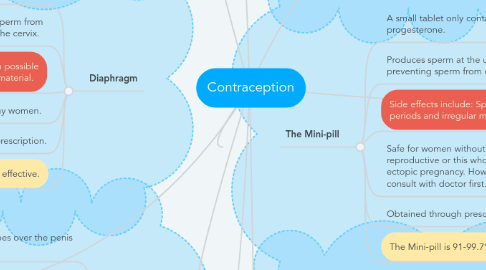Contraception
Nicholas Coffeyにより


1. IUD (Intrauterine device)
1.1. A small plastic device that is placed inside the uterus.
1.2. Hampers the sperm’s survival in the uterus. While also altering the uterus lining, preventing egg growth.
1.3. Side effects include: Cramps, Bleeding after insertion and heavier and more painful periods.
1.3.1. Cramps
1.3.2. Bleeding after insertion
1.3.3. Heavier and more painful periods
1.4. Can be used by most women, however, not recommended for women who change partner regularly.
1.5. The hormonal IUD is 99.8% effective.
2. Condom
2.1. A rubber sheath that goes over the penis when erect.
2.2. The condom prevents semen and ejaculate from entering the cervix and collects it inside the condom, where it's removed after sex.
2.3. There are usually not side affects unless allergic to the latex material.
2.4. Can be used by all males.
2.5. Can be purchased from various outlets such as health clinics or supermarkets.
2.6. The male condom is 82-98% effective.
3. Female Condom
3.1. A long polyurethane tube with a flexible ring at each end.
3.2. Inserted into the vagina before intercourse and prevent sperm from entering.
3.3. No side effects
3.4. Safe for any women.
3.5. Can be purchased from various outlets such as health clinics or supermarkets.
3.6. The female condom is 79-95% effective.
4. Implanon
4.1. A small rod with progesterone is inserted under the skin of the upper arm.
4.2. The progesterone stops ovulation while also altering the change the wall lining, preventing egg development.
4.3. Side effects include: Irregular bleeding, headaches, weight gain and sore breasts.
4.3.1. Irregular bleeding
4.3.2. Headaches
4.3.3. Weight gain
4.3.4. Sore breasts
4.4. Suitable for most men.
4.5. Inserted and removed by a doctor while using a local anaesthetic.
4.6. Implanon is 99.9% affective
5. Diaphragm
5.1. Small rubber dome that is inserted into the vagina.
5.2. When in the vagina, presents sperm from reaching the egg by covering the cervix.
5.3. Usually no side effects except a possible allergic reaction to the rubber material.
5.4. Safe for any women.
5.5. Obtained through prescription.
5.6. The diaphragm is 88-94% effective.
6. The Pill
6.1. A small tablet made up of oestrogen and progesterone, the two female hormones.
6.2. The pill stops an egg from being released from the ovaries.
6.3. Side effects include: Irregular Bleeding in-between periods, sore breast, nausea and weight gain.
6.3.1. Irregular Bleeding in-between periods
6.3.2. Sore breast
6.3.3. Nausea
6.3.4. Weight gain
6.4. Safe for most women, however, they would still consult with their doctor first.
6.5. Obtained through prescription.
6.6. The Pill is 91-99.7% effective.
7. The Mini-pill
7.1. A small tablet only containing progesterone.
7.2. Produces sperm at the uterus entrance, preventing sperm from entering.
7.3. Side effects include: Spotting between periods and irregular menstrual cycles.
7.3.1. Spotting between periods
7.3.2. Irregular menstrual cycle
7.4. Safe for women without caner in the reproductive or this who've had an ectopic pregnancy. However, should consult with doctor first.
7.5. Obtained through prescription.
7.6. The Mini-pill is 91-99.7% effective.
8. Contraception Injection
8.1. Is an injection into a muscle every 12 weeks.
8.2. Prevents pregnancy by stopping ovulation.
8.3. Side effects include: Periods may stop and a short delay in return to usual fertility.
8.3.1. Periods may stop
8.3.2. Short delay in return to usual fertility.
